Ferrari SF90 Stradale (phev) Reviews
You'll find all our Ferrari SF90 Stradale (phev) reviews right here. Ferrari SF90 Stradale (phev) prices range from for the SF90 Stradale (phev) to for the SF90 Stradale (phev) .
Our reviews offer detailed analysis of the 's features, design, practicality, fuel consumption, engine and transmission, safety, ownership and what it's like to drive.
The most recent reviews sit up the top of the page, but if you're looking for an older model year or shopping for a used car, scroll down to find Ferrari dating back as far as 2020.
Or, if you just want to read the latest news about the Ferrari SF90 Stradale (phev), you'll find it all here.
Ferrari Reviews and News
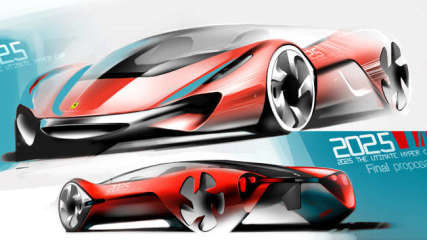
Ferrari design competition
Read the article
By Karla Pincott · 20 Jul 2011
The Eternità concept designed by Kim Cheong Ju, Ahn Dre and Lee Sahngseok of Seoul’s Hongik University took first place in the competition, which saw entries from 50 universities around the world aiming to design imagined Ferraris of the future.
In second place was the Xezri designed by Azerbaigian student Samir Sadikhov at IED in Italy’s Turin.
Third place was taken by Cavallo Bianco, designed by the team from the Royal College of Arts in London, comprising UK student Henry Cloke and Chinese student Qi Haitao.
The Eternita was judged as having best met the design brief for “a thoroughbred hypercar brimming with new generation technologies and materials, an extreme (“hyper”) car not only in its architecture but also in every other aspect”.
After drawing an initial design, the entrants then developed computer-generated 3D illustrations, and followed that with the production of a 1:4 scale model concentrating on detailing and interior features.
Common themes across the entries included alternative propulsion systems – largely hybrid – for improving fuel economy, and weight reduction to improve dynamics.
“Nurturing the creativity of young people is a fundamental strategy in every walk of life,” Ferrari chairman Luca di Montezemolo said after the prize-giving ceremony. “The Ferrari World Design Contest represents a window that we want to keep open on the world and the creative energy of the next generation. I saw at first hand the many genuinely innovative ideas that these talented youngsters sent us and could feel the enormous passion and commitment that had gone into them.
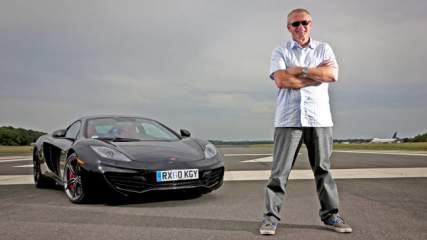
Driving on the UK Top Gear track
Read the article
By Paul Gover · 14 Jul 2011
The airfield, a former military base hidden in lush green countryside about an hour south-east of central London, is best described as shabby.Yet there is no denying the magic in the place, thanks to Top Gear. Dunsfold is the place where the world's favourite motoring show is filmed and also houses the test track where The Stig - whoever or whatever he is this week - does his stuff.Hitting the Top Gear track in the McLaren MP4-12C, with a British touring car race winner along to point the corners, is a win-win-win in anyone's book. Best of all, there are no limits. So long as the car comes back undamaged, the McLaren men are happy to have their car pushed right to the edge. After watching the Stig-ring for years on the television I think I knew it well.But the first surprise is discovering that it's actually a figure-of-eight layout, with a crossover where Chicago corner goes right and the 'tyres' take you left.The second surprise is the runway surface, which is bumpy, broken in places, skittery across some painted markings, and gives you almost zero marker points for braking and turning.So it's not an easy place to drive. It's a giant challenge in a car that cranks the speedo round past 230km/h in places and corners at well over 160.But the McLaren at Dunsfold is F-U-N. We're not playing with Top Gear slides and burnouts, just trying to learn the car and get the maximum speed and grip over every lap, and my adrenalin is pumping.Anything that gets into the 1 minute 20-second bracket on the Power Wall is quick at Dunsfold, and the McLaren settles there easily thanks to its twin-turbo V8, track-tuned adjustable suspension, giant carbon brakes and lightweight race-style construction.It whacks out of corners with a big surge of turbo thrust, brakes incredibly late, and gives you metre-by-metre feedback and grip in every corner. The back slides wide on me a couple of times, once under power and once when I misjudge my braking, and there is some turbo lag, but the 12C is basically a thoroughbred racing car with the comforts of a luxury limo.I get my last big surprise during a full-on race launch when the car rockets to 100km/h in less than four seconds before pushing me over the blind brow that hides the left-handed first corner at more than 200km/h. It is spooky fast.Just when I think it cannot get any better, Jackson chimes in from the passenger seat. "One-nineteen point four. Not bad," he says. At that point we park. Job done.
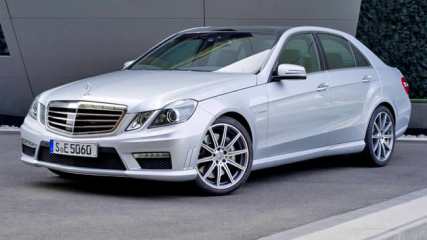
V8 cars strong in showrooms
Read the article
By Mark Hinchliffe · 14 Jul 2011
Holden leads with 12 models plus 10 HSVs, all of which are naturally aspirated. Ford was second, before it deleted all its XR8 models and handed the V8 exclusively keys to FPV which has nine supercharged V8s in its Falcons.So it's now - surprisingly - Mercedes-Benz that is runner-up to Holden in the muscle-car stakes, with 12 models, four different V8 capacities and three turbocharged choices.Mercedes-Benz Australia spokesman David McCarthy says the number will increase with the introduction of the E 63 AMG estate with twin turbo later this year."And that's in response to customer demand," he says.McCarthy calculates that V8 sales represent about $200 million a year in AMG and $50 million in other models."A quarter of a billion dollars is a pretty sizeable chunk of our business."He says V8s account for about 10 per cent of sales in most classes, except the super-costly CL 500 which is 20 per cent."That will probably change a little when we release the CL 500 bi-turbo."McCarthy says the future looks good for V8s."The reason for that is that technology is delivering lower emissions and better fuel economy without sacrificing power," he says.The ranks of the supercars are surprisingly not dominated by V8s, but by bigger cylinder capacities. For example, all Lamborghinis are either V10 or V12. The most expensive V8 in Australia is the $526,950 Ferrari 458 Italia with a 419kW 4499cc V8. If you can still find one, the cheapest is the Falcon XR8 ute with a 290kW 5408cc V8 starting at $41,690.The most powerful is the 420kW 6208cc V8 in the Mercedes-Benz SLS ($468,820) which has just 1kW more than the 458 Italia. Least powerful V8 is the 250kW 5.7-litre HEMI in the Chrysler 300C ($46,000), although the SRT version is a healthy 317kW.
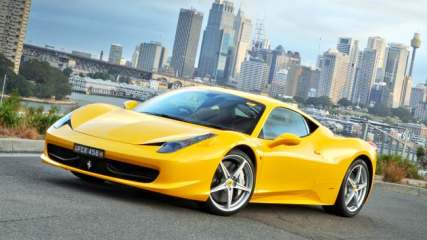
Ferrari 458 2011 Review
Read the article
By Paul Gover · 29 Jun 2011
PEOPLE who say you cannot teach an old dog new tricks have not spent any time with the Ferrari 458 Italia. It's a car that absolutely forces you to think again. And again.The latest Ferrari frontrunner is a supercar with a capital S, yet also refined and luxurious and easy - yes, easy - to drive. It's so easy and so good that it has changed this old dog from a Porsche lover into a major-league Ferrari fan.You know the question about cars for lottery wins? Well, until this week my answer was always the same - the fastest Porsche in the business, probably a 911 GT2 RS. Not now.The only real challenger to the 458, if there is one, is the all-new McLaren MP4-12C that's coming to Australia later this year.VALUEWhat can you say about a car that costs a minimum - yes, minimum - of $526,950 and competes for attention with big boy toys like boats and holiday houses and not much else unless you're talking about helicopters and private planes? The 458 Italia is massively costly, even in the rare air at the top end of the sports car business.There are other go-fast two-seaters that cost more, including the ridiculously expensive Bugatti Veyron that cannot come to Australia - no right-side steering despite a $1.2 million showroom sticker - but few that deliver the same sort of bang- for-your-buck return. The Ferrari is genuinely hand built at Maranello in Italy using huge lashing s of the most exotic and costly materials, dominated by aluminium and carbon fibre, and the Australian specification includes carbon-ceramic brakes and even an SUV-style rear-view camera.The final finishing also means choices in everything from seat sizes to leather treatments and all the rest. The 458 is stupidly costly compared to a Hyundai i20 that can also deliver you to the shops and work without fuss or trouble, or even a jet-quick, track-focussed Nissan GT-R. But when I hear that 458 customers typically spend $180,000 on extras, any value discussion evaporates. With this car, if you can then you do.TECHNOLOGYLots of rubbish is sprouted about F1 technology in road cars, but the 458 has heaps. There are active aero parts that change shape at speed, a V8 engine with 419 kiloWatts and 540 Newton-metres of torque from just 4.5 litres, an F1-style seven-speed paddle-shift gearbox, a competition- focussed differential and magnetically-adjusted race-style suspensi on. Even the steering wheel is high-tech - and the home for the wiper and turn-signal switches - with F1-style lights to signal the need for an upchange.DESIGNThe 458 is gorgeous. Simple as that. The Pininfarina design house has created a shape that is both elegant and effective, and the cabin is both driver-focussed and luxurious. Older Ferraris were awful inside and required all sorts of contortions to drive, while some of the recent efforts - the Enzo and even the new FF - challenged conventional ideas on beauty. Not the 458. It's both a looker and a worker.SAFETYHow do you really know when even the cashed-up Euro NCAP organisation cannot buy a 458 for its independent crash testing? Not that Ferrari would sell a car to have it destroyed ... On the crash-avoidance scale it rates incredibly highly, thanks to great brakes, superb steering and massive cornering grip, and what other driver is going to want to get tangled in the drama, paperwork and insurance claims of a crash?DRIVINGI don't drive the Ferrari all that far, or all that fast, but it's not necessary. In less than six hours on familiar roads in and around Sydney the 458 wins me over completely. The first 500 metres proves the Italians have tamed the beast inside the 458 but left it on a short leash for the times .. well, you know.It will trickle happily in traffic, has surprisingly supple suspension - at least, using the 'bumpy road' setting that's totally appropriate for these patchy and potholed streets - and is equipped with comfy seats, great aircon and a wonderful soundtrack from its blaring exhaust.I lash out a couple of times to sample the claimed 3.4-second sprint to 100km/h, but not the 325km/h - that's 202 miles-an-hour - top speed, and also hussle through some corners and give the brakes a bit of a punish. But the 458 is never remotely troubled and switches straight back from F1 fast to Hyundai humble in a flash.I admit there are some moments in the Harbour Tunnel, with the cruise control locked below the legal limit, that I tickle the seven-speed twin-clutch gearbox just to hear the wonderful music the car makes. I am also absorbed by the luxury, enjoy the technology and feel of the wheel, and feel flat-out scared as I edge through a two-small parking garage.There is no sign of the 'small man' signals I expect, but perhaps that's because the car is yellow and not look-at-me Ferrari red. The 458 reminds me so much of my best mate, Mark. He's one of those blokes who is wonderfully mannered, relaxed, refined, smart and great company, but quite capable of making the difference - in your favour - if things really turn nasty. In the Italia you can be cruising happily at 60km/h in stop-start traffic knowing - hoping?- that if the road ahead unravelled into a grand prix track the car would be just as good. No, it would be far, far, far better and better than even the most talented non-race drivers. The 458 is a car you can love. And I do.VERDICTAn utterly brilliant drive and a landmark car. The only reason it doesn't get a perfect score - yet - is its price and an upcoming run in a McLaren MP4-12C. Then we'll know ...FERRARI 458 ITALIAPrice: from $526,950Safety: Not tested by NCAPEngine: 4.5-litre, V8 petrol, 419kW/540NmBody: two-door coupeWeight: 1485kgTransmission: seven-speed dual-clutch manual, rear-wheel driveThirst: 13.3L/100km, CO2 307g/km"Would you? Of course you would."
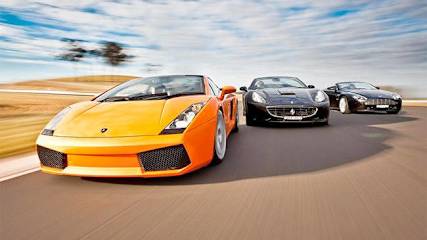
Supercar safari
Read the article
By Lee Taylor · 20 Jun 2011
But here I am behind the wheel of not one, but two Ferraris, a Lotus, a Lamborghini, an Aston Martin and a Porsche.
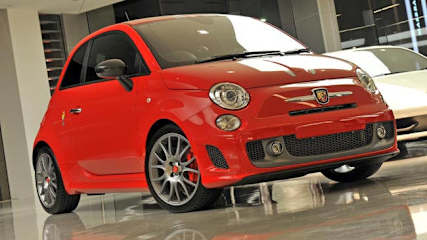
Abarth 695 Tributo Ferrari lands
Read the article
By CarsGuide team · 15 Jun 2011
The red $70,000 pocket rocket has a top speed of 225km/h and does the dash from 0-100km/h in less than seven seconds. It's been built as a tribute to the historic performance links between Ferrari and Abarth.
The Abarth 695 Tributo Ferrari is fitted with a 1.4 Turbo T-Jet 16v, tuned to develop more than 132kW of power. This is combined with an MTA (Manual Transmission Automated) electromechanical gearbox with race-inspired steering wheel controls that enhances engine's performance by reducing gearshift times. It rides on 17" alloy wheels featuring a design inspired by Ferrari wheels.
Ride and braking systems have also been strengthened to cope with the extra power: modular Brembo 305mm disc brakes with fixed four-piston calliper disc and special shock absorbers that let you enjoy performance in total safety. And of course there is a "Record Monza" variable back pressure "dual mode" exhaust, designed to improve engine performance and deliver an inspiring sound over 3000 revs.
Still, it's a lot of money for a tiny car.
The Tributo Ferrari is finished not just in classic Modena Red, but also in the brand-new shade of Modena Yellow, with carbon fibre door mirrors and B pillar trims. Details such as the wheels and front air intakes are in Racing Grey.
"Abarth Corsa by Sabelt" carbon fibre racing seats are fitted and finished in black leather and Alcantara with a shell and seat base in carbon fibre.
The list goes on ... but it's a lot of money for a tiny car. The interior is embellished with other details too, like the special kick plate passenger footwell, door sill trim and a plate bearing the vehicle series number. The Tributo Ferrari comes with a special pack to keep it safe and clean.
The safety pack includes a dedicated travel bag with an emergency triangle, work gloves, emergency lights, and an Abarth yellow safety vest. The cleaning kit includes Abarth Leather Cleaning Fluid, Abarth Body Wax and Abarth Interior Cleaning fluid. It even comes with its own personalised car cover.
The standard Abarth Travel Pack comprises of a set of "stone washed" black leather luggage designed specifically for the luggage compartment of the Abarth 695 "Tributo Ferrari".
The Abarth 695 "Tributo Ferrari" has a recommended retail price of $69,990 excluding statutory charges, delivery and dealer costs.
The bad news is that all 45 of the cars destined for Australia and New Zealand have been sold.

Supercar special editions
Read the article
By Philip King · 15 Jun 2011
If you already have a garage of off-the-shelf exotica, your next purchase needs to be something really special.FERRARI SUPERAMERICA 45THE most committed (and cashed-up) Ferrari aficionados build up a relationship with the brand through long association, and buying lots of cars. Ferrari knows them by name and likes to think of them as family. One such is New York real estate supremo Peter Kalikow, who has an impressive car collection that includes vintage Ferraris.When it comes to buying something new for a special occasion, Kalikow likes to commission Ferrari's special projects department. Then it's a case of tell them what you'd like, and they'll knock one up.This year, to mark 45 years as a customer, Kalikow took delivery of the Superamerica 45, a one-off set of wheels based on the 599 GTB. It was unveiled last month, like so many of these cars, at the annual Villa d'Este Concorso d'Eleganza on the shores of Lake Como, Italy.The bespoke Superamerica 45 design features a rotating carbon-fibre roof, including the rear glass, which flips into the boot to turn the coupe into a convertible. This idea appeared on a version of the 575 Maranello, the predecessor to the 599 GTB, and was also called Superamerica.Kalikow was also inspired by a car in his collection: a 1961 400 Superamerica cabriolet, which was an equally exclusive vehicle a half century ago. The bodywork and wheels of the 45 are painted the same blue to match. The car's carbon fibre elements, including the roof, body kit and much of the cabin, are in a contrasting darker blue. The chromed grille, burnished aluminium A-pillars, wing mirrors and door handles are also unique.Changes to the bodywork include rear buttresses integral with the rear wheel arches and air vents in the front wings, while the boot had to be redesigned to fit the roof.Ferrari says nothing about what's under the bonnet of this car, but a standard 599 GTB is powered by a 456kW 6.0-litre V12.Kalikow is no stranger to customised Ferraris, having previously ordered a special version of the 612 Scaglietti, the brand flagship that recently made way for the FF.Ferrari doesn't reveal the price of these cars but its best-known special project recently was the P4/5 from 2006, a Pininfarina design based on the Enzo supercar. It was a one-off ordered by US financier James Glickenhaus that reportedly cost $4 million.ASTON MARTIN V12 ZAGATOITALIAN specialist Zagato has been in the bespoke design and production business for more than 90 years and its long association with elite brands extends beyond its homeland to take in the racier badges from Britain.Its most recent car is the Aston Martin V12 Zagato, which was built to mark the 50th anniversary of the first project between the two, the DB4GT Zagato of 1961. Only 20 of those cars were made and it has spawned many replicas. DB4GT originals have become very collectable and fetch millions of dollars.The modern reinterpretation of the DB4GT starts life as the Vantage, Aston's junior sports car, in its most extreme form with a 380kW, 5.9-litre V12 under the bonnet. Like that car, it features a limited slip differential and carbon fibre propeller shaft, but it drives through an automated six-speed manual instead of a traditional manual.Most noticeably, the bodywork is all bespoke and handcrafted out of aluminium using traditional techniques and body bucks. To make the double-bubble roof alone takes five pieces of aluminium, joined and shaped into one flowing form. The front wings need seven pieces each.Like the DB4GT, the V12 Zagato will go racing, with an appearance planned for the last weekend in June at the Nurburgring 24-hour race in Germany. The V12 Zagato in race trim has reduced weight and retuned suspension as well as a 120-litre fuel tank, rollcage and huge rear wing.At the car's debut at the Villa d'Este concours last month, it scooped the prize for best design. Company chief executive Ulrich Bez was encouraged: “Based on the reactions of our customers to this race car, we hope to offer a road-homologated V12 Zagato in a small, limited number as soon as possible.'' According to Aston insiders, there's at least one Australian in the queue to buy.ALFA ROMEO TZ3THE takeover of Chrysler by Fiat is already throwing up some oddities, including a whole line-up of Lancias that are little more than rebadged versions of American cars. And that's just the start.To celebrate the 100th anniversary of Fiat-owned Alfa Romeo last year, former race partner Zagato designed the TZ3, named for the TZ race cars that campaigned in the 1960s. Built for German collector Martin Kapp, who owns TZ originals, the TZ3 first appeared as the Corsa at the Villa D'Este showpiece in Italy last year.Designed for lightness, it's built on a carbon fibre monocoque with a hand-formed aluminium body. Under the bonnet is a 4.2-litre V8 driving the rear wheels through a six-speed sequential gearbox. With a kerb weight of just 850kg, it can reach 100km/h in 3.5 seconds.As its name suggests, the Corsa was designed as a track car, and it's unique.Production of the TZ3 Stradale, which followed this year, will run to nine examples and it shares many design features with the Corsa, including the aerodynamic tail shape that was pioneered by the 1960s TZ racers. But the Stradale is fundamentally different.Its body is formed from carbon fibre and underneath sits the chassis from the most extreme form of Dodge Viper, Chrysler's blue-collar supercar.Power comes from the Viper's monster 450kW 8.4-litre V10.Unlike the Corsa, the Stradale is road legal and, in effect, the first American Alfa Romeo. Suitably enough, the first example went to collector Eric King in the US.Meanwhile, Chrysler and Fiat are denying that future production versions of the Viper will share mechanicals with Alfa. Although worse things can happen, as Lancia can attest.Read more about prestige motoring at The Australian.
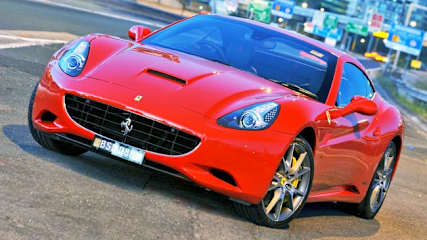
Ferrari California 2011 Review
Read the article
By Peter Barnwell · 14 Jun 2011
Supercar makers are acting quickly to "green-up" their cars in the face of ever tightening emissions limits across the globe. But it's not a gloom and doom story for died-in-the-wool petrol heads as demonstrated by Ferrari with its California HELE (High Emotion Low Emissions) model.It's the vanguard of other HELE models in the Ferrari range that may eventually all feature the planet-saving technology used in the California. For some reason, Ferrari still makes a non-HELE version of the California though we don't know why.TECHNOLOGYA brief test drive of the HELE model emphatically demonstrates there is no down-side to this technology. It is exactly the same, possibly better to drive than the non-HELE model thanks to engine stop/start and other features such as a weight reduction, improved aerodynamics and an adaptive, seven-speed double clutch gearbox.Engineers went into detail to save emissions particularly via reduced electricity demands. They improved efficiency using an air conditioner compressor with variable displacement, brushless electric engine-cooling fans, an on-demand electric fuel pump and other little tricks.The net result is a significant reduction in fuel consumption now down to 11.5-litres/100km on the combined cycle. This in turn reduces carbon dioxide emissions to 270g/km _ or a little better than Falcon or Commodore sixes. This also represents a 23 per cent reduction compared with the standard California. All this with no loss of the exhilarating performance and driving experience for which Ferrari is renowned.California HELE is still capable of dispatching the dash to 100kmh in less than four seconds and going on to a top speed, where the law permits, of 310 kmh.The HELE package enhances driving performance by releasing torque (+25Nm) from more mundane purposes to lift responsiveness.DRIVINGOn our drive, the California HELE showed whip cracking performance and gear changes along with superlative handling qualities.It remains a joy to hear especially with the roof off.The stop/start system is unobtrusive and the fact that the HELE car uses less fuel is a bonus because you don't have to visit the service station as frequently.Ferrari has taken its green efforts further by implementing extensive environmentally sustainable systems at its Maranello factory _ solar power, rainwater harvesting, gardens in the factory.It is completely autonomous for its energy requirements. This reduction also means that Ferrari will meet the Kyoto protocol objectives a full 10 years ahead of schedule and with double the figure imposed on Europe.For some reason the California attracts a premium of $2750 for technology that should be adopted across the board and not cost any extra.FERRARI CALIFORNIA HELEPrice: $462,400Warranty: 3 years/unlimited kilometresResale: 63%Service interval: 12 months/15,000kmSafety equipment: ABS, EBD, EBA , TCCrash rating: 5 starsEngine: 4.3-litre V8; 338kW/510NmBody: 2-door, 2-seaterDimensions: 4563mm (L); 1308 (H); 1902 (W); 2670 (WB)Weight: 1735kgTransmission: 7-speed dual-clutch auto; RWDEconomy: 11.5L/100km; 270g/km CO2

Ferrari FF interior 360 view
Read the article
By Karla Pincott · 09 Jun 2011
Scroll down to see our 360 degree inside view of the new FF.
A family-car Ferrari sounds like a contradiction from a brand famed for F1 ultra-performance. But that’s exactly what the Prancing Horse has done in building the Ferrari FF. And they’ve made it four-wheel drive … perfect for battling the rough terrain of the private school drop-off zone.
The $625,000 car - the first of which landed in Australia this week on its world trip to entice potential customers - is the successor to the 612 Scaglietti. It carries a 486kW/683Nm direct-injection 6.3-litre V12 with its block modified from the 612, mated to a dual-clutch seven-speed transmission with steering wheel paddle-shifters.
The engine sits behind the front axle line so the drive out to the front wheels comes off the nose of a new crankshaft. There are three transmission/engine management modes: automatic, sport and race. The traction system is switchable from wet, ice and snow to - for the brave - ESC completely off.
It gets to 100km/h in just 3.7 seconds and the massive carbon-ceramic Brembo brakes on the 20-in wheels it back from that speed to a dead stop in 2.7 seconds - and 35m.
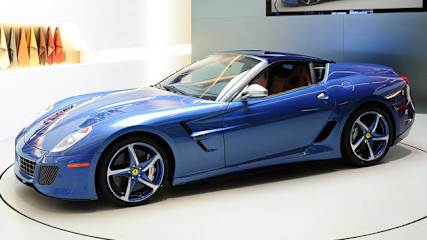
Ferrari Superamerica 45 a one-off
Read the article
By Mark Hinchliffe · 20 May 2011
HENRY Ford would roll over in his grave. He once said about the Model T: "Any customer can have a car painted any colour that he wants so long as it is black."
Today's customers for prestige cars can chose from so many trim options it is possible that no two cars of the same model would be the same. Maserati, for example, has nine million possible trim, colour and leather combinations, a figure that has doubled in the past three years.
One Australian family is even reported to have chosen a bespoke Maserati Quattroporte with four different leather seat colours to match the favourite colour of each member of the family. Ferrari runs a Special Projects program where customers can create a one-off special.
For example, New York Ferrari collector and enthusiast Peter Kalikow has taken delivery of this one-off Special Projects Ferrari Superamerica 45 to celebrate 45 years since he first became a Ferrari client.
It features a carbon-fibre rotating hard-top, a carbon-fibre boot, chromed front grille and special burnished aluminium A-pillars, wing mirrors and door handles.
The Superamerica 45 is finished in Blu Antille to matches Kalikow's 1961 400 Superamerica cabriolet. The wheels are body-coloured with contrasting diamond-finish spokes. The roof and other carbon-fibre elements of the bodywork are in a special contrasting darker blue, a theme that is carried over to the cockpit which features dark blue carbon-fibre dash trim and driver zone.
The interior features a combination of Cuoio leather trim and Blu Scuro carbon fibre details and a latest-generation touch-screen infotainment system. No Australian customer has yet ordered a car under Ferrari's Special Projects program.
However, every Ferrari that comes into Australia is personalised to individual customer's particular requirements. And there is a lot to choose from.
For a start there are three different types of seat: standard, carbon fibre racing and carbon fibre racing with electric adjustment. These then come in small, medium or large sizes.
The standard seat may have the normal upholstery style, Daytona or Diamond pattern, then different parts of the seat may use differ types of leather in different colours or be combined with Alcantara. The stitching can be the same colour or different colours, in different stitching styles or piping may be used.
But wait there's so much more. The seat belts come in different colours, the boot may be carpet or Alcantara and so on.
And what about colours? There is a standard range, an historic range from Ferrari's history or customers can choose any colour they like. Even choosing a red Ferrari involves a choice - classic Rosa Corsa, Scuderia Red of the F1 team or three darker metallic and pearlescent reds.
A Ferrari spokesman says it usually takes a customer three to four hours to work out the exact specification for their Ferrari.




